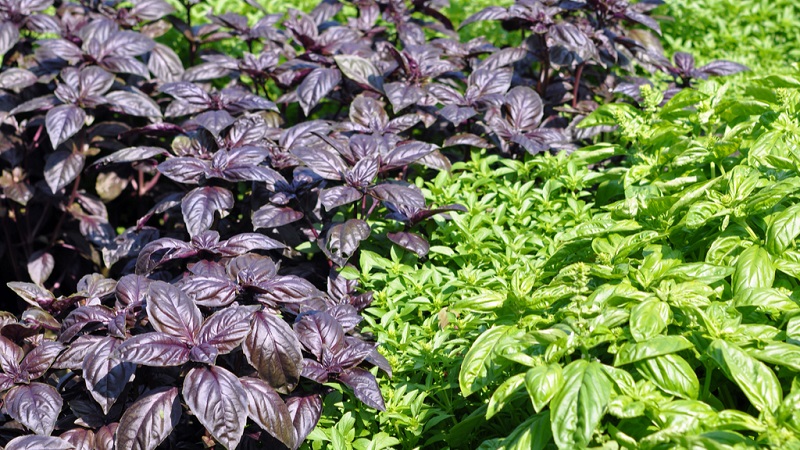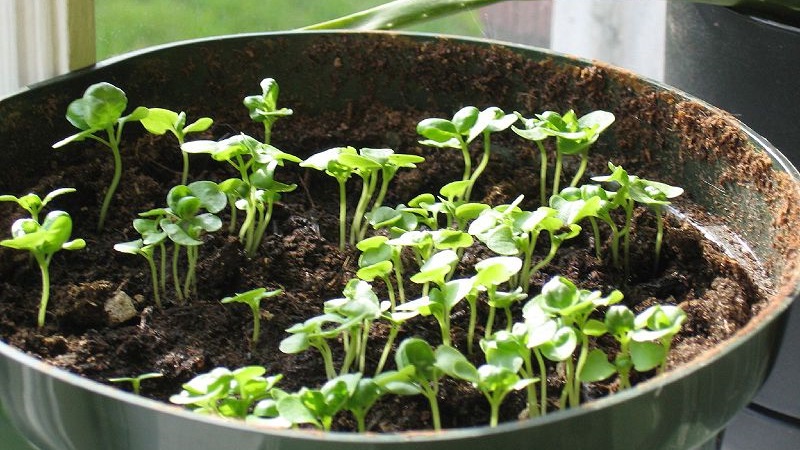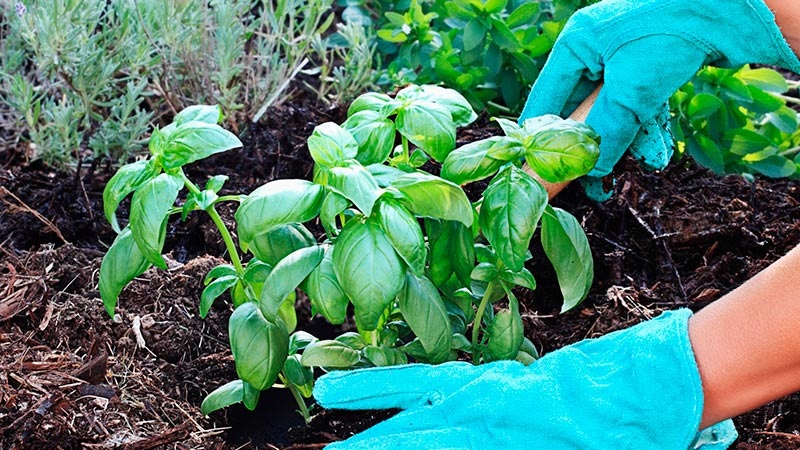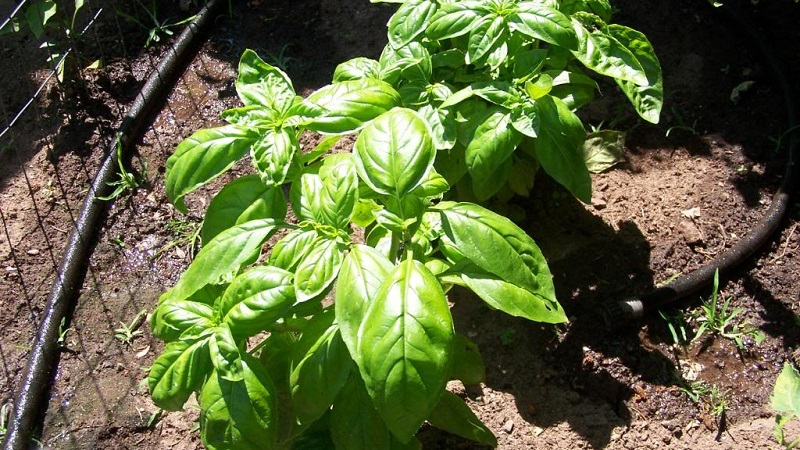How to grow basil outdoors in the Moscow region
Basil transforms any dish with its unique aroma. The plant is native to South Asia, so it loves light and warmth. Such exactingness to light and temperature conditions does not mean that the culture is not adapted to growing in central Russia. Receive good harvest will succeed in greenhouses and even on the windowsill.
To prevent planting in open ground from capricious weather, use the seedling method. It allows the plant to grow stronger in favorable conditions, and with the arrival of stable heat "move" to a permanent bed.
The content of the article
The best varieties of basil for the Moscow region
In the State Register of Breeding Achievements of the Russian Federation, there are no recommendations for zoning for vegetable basil. However, common sense and the experience of gardeners suggests that for the agro-climatic conditions of central Russia, cold-resistant early varieties, the period from full shoots to ripening in which takes 20–45 days.

These varieties are sown in open ground.:
- The pearl of the Moscow region - bred in 2013, the aroma of the greenery is unusual, with notes of lilac. The stem is long, erect. Leaves of mixed anthocyanin color. The mass of one plant is 370 g. Productivity is 3.5–4 kg per 1 m².
- In memory of Yuri Fadeev - one of the youngest varieties included in Rosreestr in 2017. High-yielding (4–5.5 kg / m²). The bush is medium-sized, the color of the leaves is dark green with purple patches. The aroma is clove. Suitable for seedless cultivation, resistant to cold, drought and moisture retention.
- Pepper flavor Is a medium-high variety with purple leaves. Plant weight - 200 g. Productivity - 3.8-4.2 kg / m².
- Aromatic goulash - basil of the Ural selection, included in the register in 2019. Plant of medium height and anthocyanin coloration. The aroma is clove. Bush weight - 380 g, yield - 4.2 kg / m².
- Delight - high yield (4.8 kg / m²). Due to the strong foliage, the mass of one plant reaches 500 g. The leaves are smooth, dark purple, the aroma is clove.
- Lemon - green-leaved variety of medium height. The aroma is intense lemon. Productivity - 2.7 kg / m². One bush weighs up to 530 g. Basil ripens in 45-55 days.
For growing through seedlings, medium-ripe basil is suitable (50–70 days from germination to economic validity):
- Moskvoretsky Semko - gives compact bushes up to 40 cm high. Leaves and stems are purple. Plant weight - 180–280 g, yield - 1.5–2.5 kg / m². The cultivar is prized for its decorative appearance and strong clove aroma.
- Marquis - cold-resistant grade. Semi-spreading, highly branched plant, about 25 cm tall. Leaves are small, elliptical, green in color. The aroma is clove-pepper. Productivity - 1.5 kg / m², bush weight - 150 g.
- Velvet - the bush is low, up to 30 cm in height. The leaves are dark green with a menthol scent. Although the mass of the bush reaches 350 g, the yield is average: about 2 kg / m².
Vegetable growers, those wishing to grow basil with an unusual aroma will appreciate the anise varieties (Aniskin, Ararat), Pomegranate Muscat with Muscat-Pepper Scent, Vanilla Aroma, Caramel and Cinnamon, whose names speak for themselves.
How to grow basil from seed for seedlings
Given the changeable climate of the Moscow region, the high risk of recurrent frosts and insufficiently fertile soil, the most efficiently growing basil seedling method... It is undesirable to plant seeds directly in open ground, since sudden changes in air temperature and stagnant water in the soil will ruin the crop.
To increase the germination of seed, it is kept in a warm place for 2 weeks. Potassium permanganate solution is used for disinfection: the seeds are soaked in it for 20-30 minutes.
Sowing begins about 2 months before planting in the garden... For the Moscow region, the approximate date is the end of March.

Soil and container for seedlings
Basil loves loose and nutritious soil... Several options for an earthen mixture for growing spicy greens are optimal:
- Rotted manure, peat, washed sand in a ratio of 2: 4: 1.
- Peat, garden soil, humus in equal parts. They are sifted, disinfected in a water bath or in dry heat.
To increase the nutritional value of the soil, it is sprayed with planting solution.: ½ tsp each. potassium sulfate, potassium chloride, urea and superphosphate per 5 liters of water.
Attention! Another important condition is high-quality drainage, since basil does not tolerate stagnant water. An unpleasant consequence of excessively moist soil is root rot in seedlings. Therefore, vermiculite, perlite, expanded clay, gravel, crushed brick or sand are placed on the bottom of the container.
For growing seedlings use containers at least 10-15 cm deep, since the plant has a developed root system:
- general container: wooden boxes, cut 5 l cans and plastic bottles;
- single containers: peat tablets, pots, 500 ml plastic cups.
So that the seedlings do not stretch from a lack of light and heat, think over the system of additional lighting and heating in advance... The basilica requires approximately 16 hours of light a day.
Seeding Algorithm
To grow seedlings:
- The prepared soil mixture is moistened with warm water.
- Basil seeds are sown on the surface and sprinkled with a small layer of soil, thus deepening by 0.5-1 cm. So they will "hatch" faster, and after emergence of seedlings sprinkle earth around the stems.
- Through a sprayer, the soil is moistened again with settled water at room temperature.
- Seedling containers are covered with foil or glass.
Further care is:
- daily ventilation: for 20-30 minutes the film is removed and the formed condensate is removed;
- maintaining the temperature regime: + 20 ... + 25 ° C - before the emergence of shoots (it will take about a week), + 16 ... + 20 ° C - after (this way the shoots will not stretch out);
- moistening as the soil dries up;
- thinning: between the plants leave from 7 cm (seedlings dive when they reach 5 cm);
- top dressing: 10 days after picking, the soil is watered with a nutrient solution (for 1 liter of water, 2 g of ammonium nitrate, 2–4 g of wood ash and 4 g of superphosphate);
- hardening in the open air at a temperature not lower than + 5 ° C (start 2 weeks before planting in open ground).
When growing seedlings, there is a great risk of developing a black leg... Signs of a fungal disease: darkening of the stem base, thinning of the basal neck, lethargy of the aerial part. This is due to the thickening of the plantings, sudden changes in temperature, excessive moisture and watering with cold water. Therefore, it is important to protect the seedlings from drafts, and use settled warm water for irrigation. For prevention, the earth is sprinkled with wood ash mixed with sand.
Landing in open ground in the suburbs
When the threat of frost has passed, the prepared seedlings are planted in a permanent place.: open bed or greenhouse.

When to plant
The landing time depends on several factors.:
- seedlings should have 4-6 true leaves - younger shoots are too weak, and when transplanting more mature plants, there is a high risk of damaging the root system;
- the soil is warmed up to + 14 ... + 16 ° C.
Tentative dates for the middle lane are late May - early June... Even if sudden cold snaps are expected during this period, temporary shelters are placed or the landing is postponed. In the latter case, the shoots are pinched over a 6–8 leaf.
Advice! For planting, choose a cloudy day so as not to dry out the plant.
Transplant rules
When choosing a place on the site, take into account:
- Soil quality... Basil prefers nutrient-rich, loose soil with a neutral pH. Black earth is ideal, but in the conditions of the Moscow region, loam and sandy loam will do. The beds are dug in advance, weeds are removed and fertilizers are applied: humus, manure, peat. Sand will help to lighten heavy soil, and lime will deoxidize.
- Crop rotation... Favorable predecessors: legumes, cucumber, tomato, potatoes, winter cereals. Basil is planted in the same place no earlier than 2-3 years later to avoid fusarium infection.
- Abundance of sunshine and protection from strong winds.
Culture is used in joint landings: it gets along well with legumes, tomatoes, bell peppers, zucchini, lettuce. The neighborhood with spicy greens protects these crops from pests: aphids, spider mites, leaf beetles and others.
Recommended scheme for growing basil outdoors - 15–25 × 30 cm. The plant is planted in moist, heated soil to a depth equal to the individual seedling container. The roots should not clump or curl up. After planting, each bush is watered with warm water and mulched with a layer of humus or dry earth.
How to care for basil
If the seedlings are properly grown and have taken root in an open garden, basil care won't be a hassle. It is enough to water it in a timely manner, feed the plant from time to time and loosen the soil.

Watering
Basil needs regular, but not over-watering warm water as the soil dries. The soil should be moderately moist, since the culture does not tolerate either drying out of the soil or stagnant water. The best time to moisturize is evening.
Weeding and loosening
So that a crust does not form on the surface of the soil, which prevents the access of oxygen and moisture, loosening is carried out after each watering... At the same time, weeds are removed, as they shade the plantings and interfere with the full absorption of nutrients.
Reference! Once a week, the garden bed is sprinkled with wood ash to prevent blackleg, fusarium and gray rot.
Top dressing
Basil responds well to fertilizers... Nitrogen fertilizing contributes to the growth of green mass. Phosphorus and potassium maintain a high level of essential oil in the leaves, which is responsible for the spicy flavor and aroma of the plant.
For feeding use:
- nitrophosphate - 2 tbsp. l. for 10 water, for processing 1 m2 planting will take 5 liters of solution;
- urea (urea) - 1 tbsp. l. 10 liters of water.
The first feeding is carried out 10-15 days after planting plants in open ground, subsequent - every month.
If the soil has been properly fertilized with organic matter, mineral fertilizers are also dispensed with.... Regular pinching of the top (after the appearance of 5-7 strong leaves on the stem and side branches) increases the splendor of the bush much more effectively. This stimulates the emergence of new shoots. If inflorescences are formed, they are also removed, otherwise the bush will quickly wither.
Conclusion
With proper care, the summer heat and sun is quite enough for growing basil in the Moscow region. They enjoy fragrant greenery until the autumn frosts, and if you dig a bush out of the garden and transplant it into a pot, it will overwinter perfectly on the windowsill.